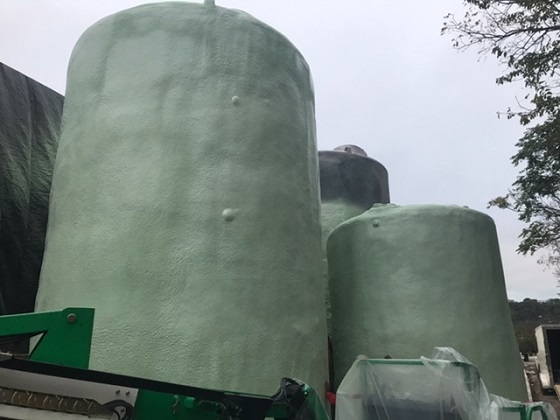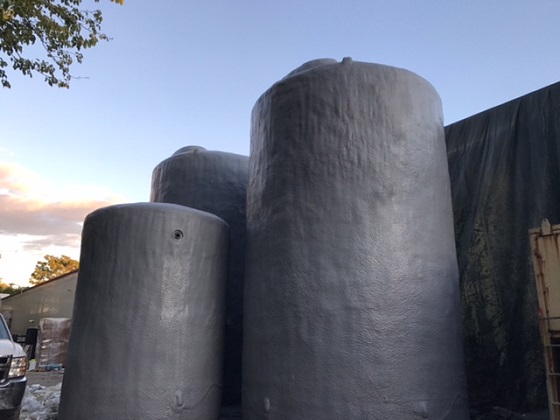Based in Shelbyville, Kentucky, between nearby Louisville and Cincinnati, Ohio, Spray-Tec Inc. is a commercial roofing and insulation company specializing in spray polyurethane foam (SPF) application. So when a U.S. government vendor near Cincinnati contacted Spray-Tec in 2017 with a roofing inquiry, the contractor made sure to mention its other capabilities. As it turned out, it was the insulation component that led to an even bigger job.
“The tanks at the facility store deionized water, which is used to flush and cool electrical discharge machining (EDM) processed parts,” said Roger Jordan, vice president of Spray-Tec. “They were located outside and required a consistent temperature to maintain year-round operations. While on site, our sales manager mentioned our capabilities to insulate the [existing] tanks. The options to construct and insulate a new addition to the facility were cost prohibitive.”
Cold Crew
Spray-Tec and its three-person crew were happy to take on the assignment, but they knew they had to work quickly upon arriving at the jobsite in October 2017. From the client’s perspective, the onset of winter meant having to manually heat the site’s plastic tanks so that the contents would not freeze and affect their production line.
“Spraying the tanks with foam eliminates freezing and gives the customer piece of mind,” Jordan said. “No longer having to constantly heat the tanks manually saves them money and resources.” The full scope of the 3,740-square-foot (347.5 m2) job consisted of the exterior of three 15,500 gallon (58,673.9 L) water tanks, as well as ancillary items such as one 5,000 gallon (18,927.1 L) storage tank and one cone bottom tank.
The short window to complete the job wasn’t just because of the client. The weather conditions were critical to the applicators, too! “The temperature to apply foam should be at 40 °F [4.4 °C] with calm winds and dry, sunny conditions,” Jordan said. “These conditions can be hard to rely on in the fall and in Ohio.”
Due to cold and rainy weather from an early season cold front, weekend work became out of the question. On those days, crew members returned home for a brief break.
Above and Beyond
Upon arriving at the jobsite, the Spray-Tec crew went through extensive safety training for most of the first morning. From there, the crew moved equipment into a confined staging area and began masking nearby areas of the plant to protect against potential overspray.
“There was a lot of masking for sure! It was an active plant, and the tanks were a tight squeeze. We were very close to the adjacent building,” Jordan said. Masked items included the adjacent building; heating, ventilation, and air conditioning (HVAC) equipment; the concrete pad; and equipment controls attached to the sides of the tanks.
In addition to surrounding areas, crew members had to protect themselves, too. Personal protective equipment (PPE) included MSA Safety’s Advantage 200 half-mask respirators; harnesses and retractable lanyards by Guardian Fall Protection and 3M’s DBI-SALA; and gloves from Protective Industrial Products (PIP).

Because of the position of the tanks — both the proximity to one another and the building — an aerial lift was used as much as possible to access the tall tanks, which ranged from 16 to 20 feet (4.9 to 6.1 m) in height. That still left 50 percent of the area to be sprayed from a combination of scaffolding, ladder jacks, and Little Giant ladders.
Three Tanks, Three Steps
With precautions and access plans in place, the Spray-Tec crew began moving tank to tank through the facility. Because the tanks had not been previously coated, surface preparation needs were minimal. “We had to solvent wipe a couple of areas that had some grease on them, and then we got started with the primer process,” Jordan said. “That was about it!”
Using a Graco rig, step one of each tank’s three-step process was spraying on the two-component, water-borne GacoFlex E5320 epoxy primer from Gaco Western at approximately 4–6 mils (101.6–152.4 microns). Then, the closed-cell GacoRoofFoam SPF was applied using a Graco proportioner to achieve a total average of 2 inches (5.1 cm). The third and final step was spraying on the GacoFlex S2029 100-percent silicone coating in a light gray color.
During week one, the crew applied the SPF and applied the first coat of silicone to one of the main three tanks and parts of the two others before the cold front forced them off site for the weekend. Once temperatures returned to suitable coating levels, the crew returned to finish the last two tanks and ancillary items. Masking was removed to enable crew members to trim the SPF around control boxes, pipe fittings, and electrical conduits, while any areas needing touchups to the basecoat received the personal touch of brushes and rollers. The tanks were then re-masked to protect the controls, and a second coat of silicone was applied. The solvent-free, waterproof elastomeric silicone was applied using a Hennes-Johnson airless sprayer at an average of 36 mils (914.4 microns) combined.
The topcoat, touchups, and jobsite cleaning were completed by the middle of the second week, which meant the job was finished within the original 10-day estimate — even though they lost two days due to weather. “To make up for lost time, the crew hustled, cut their lunches short, and worked extra hours with urgency to ensure completion on schedule,” Jordan said.
Three Wins
Thus far, the client’s feedback on the job has been quite positive. “The customers were extremely pleased with the look and performance of the insulation,” Jordan said. “They also shared that our price was considerably less than mechanically installed insulation, and the R-value was better. A win-win!”
The crew members who were there throughout the project — Javier Cruz, Chris Gabeheart, and Miguel Avila — were winners as well. “Javier, Chris, and Miguel went above and beyond to ensure customer satisfaction,” the Spray-Tec vice president said. “Their attitudes remained positive despite setbacks, and the customer was so pleased and impressed by the work that he took them out to dinner on the last day.”
By the end of this job, both the client and contractor had wins to celebrate.
